Step By Step from Birth to Maturity
 Puppy Development Stages
Puppy Development Stagesby Janice Jones |Last Updated 02-07-2020
People often think of their small dogs
as babies and themselves as parents.
Parents want to understand puppy development so they can predict what comes
next.
Just like human development, puppy
development follows a predictable sequence, but unlike children, dogs
pass quickly through these phases.
Yes, puppies grow up fast. In the wink of an eye, your little puppy will
become an adult, so as a puppy parent, you don’t have much time to loose.
Small dogs,
in particular, mature fast, much faster in fact than even large breed
dogs. By the time they are ten months
old, many small breed dogs have achieved adult reproductive status and look and feel like an adult dog.
Experts cannot agree
upon exact ages as some breeds and even dogs within breeds develop at different
rates. But the stages of development are
predictable.
There are seven stages of puppy development not including the adult
stage.
Puppy Development Stages
- Neonatal Period: Birth to Two Weeks
- Transitional Period: Two to Three Weeks
- Awareness or Identification Period:
Three to Four Weeks - Second Awareness or Identification: Four to Five Weeks
- Socialization Period: Five to 16 Weeks
- Flight Instinct Period: 4-8 Months
- Second Fear Impact Period: 6-14 Months
- Maturity: 1-4 years
During the Socialization Period, there are several sub-phases
- Curiosity: 5-7 Weeks
- Behavioral Refinement: 7-9 Weeks
- Fear Imprint/Impact: 8-11 weeks
- Environmental Awareness: 9-12 Weeks
- Seniority Classification Period 13-16 Weeks
Puppy Development Stages: Neonatal Period (Birth – 2 weeks)
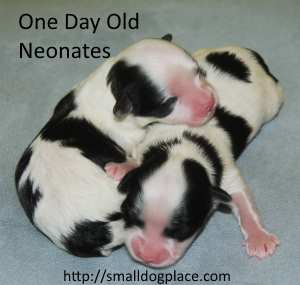
At birth, your puppy’s eyes and ears
are closed. In fact, only 3 senses are working—touch, taste, and smell
and even then they are not entirely
developed. Puppies feel and respond to pain, discomfort and minor
disturbances by whining or crying.
Their body temperature is well below
that of a mature dog, and they are unable to tolerate a cold environment.
Neonates
have a body temperature of about 94 to 96 degrees F. The normal temperature for
older puppies and adults is 101-102 degrees F.
For optimal puppy
development, the room temperature must be kept hot and breeders accomplish this
by maintaining room temperatures around 80 degrees and providing heating lamps
and/or heating pads.
Puppies of this age are also
incapable of either urinating or defecating on their own and depend on their
mother to stimulate this process.
Their first mission in life is to
find warmth and food. They have no teeth, but their nails are fully developed
and some may even need trimming in the first week of life. Their primary activity at this time is to search out
nourishment from their mom and sleep.
Newborn puppies sleep most of the time,
often as much as 90% of their time. While asleep they often twitch and move only to re-position their body.
Twitching
occurs because at this point in their young lives, they sleep is the REM stage,
a stage characterized by high brain activity.
Beyond that, they have
little interaction with litter-mates or
the environment other than to huddle close to litter-mates and mom for
warmth.
The mother
dog provides the warmth, the food, and cleans up after all pottying activity, a
job that mother dogs accept happily.
Puppy Socialization should begin the day he is born and continue throughout puppyhood. It is up to the breeder to provide this type of stimulation so that the puppy becomes a well adjusted adult.
Barking is weeks away, but small
vocalizations can be heard that resemble whining or crying. Neonates will vocalize if they are being laid
on, hungry, or in distress.
Puppy Development Stages: The Transitional Period (2-3 weeks)
At around two weeks of age, the puppy’s
eyes open and then several days thereafter, their ears open. At first
their vision is blurry but soon vision improves and the puppies can now see the
world at least from their vantage point.
Once their ears open they may
begin to startle when they hear sounds. Even from the very beginning,
their range of hearing is nearly twice that of humans and into the ultrasonic
range.
At three weeks of age, puppies become
somewhat adventuresome and begin to move
around more, though they are not very sure footed at this age. This might
be equivalent to the crawling stage in the human infant.
Their eyesight
and hearing are improving daily. This is also the time that they begin to
lap liquids and mouth solid foods if the consistency is mush-like.
They also begin to
have limited interaction with litter-mates.
The majority of this interaction revolves around who is going to serve
as a pillow and who is going to serve as blanket as they pile up in one small
corner of the whelping box.
Puppies take turns sleeping on
top of the pile and cuddling underneath and don’t seem to mind either position.
They also begin to paw at each other and may try to bite at each others faces.
The initial eruption of teeth occur by
the end of the period, but there won’t be enough teeth to manage hard kibble
for several more weeks.
Sometime
during this phase, they are able to eliminate on their own and will start to
crawl out of their whelping box to
eliminate.
Puppy Development Stages:
Awareness or Identification Period (3-4 Weeks)
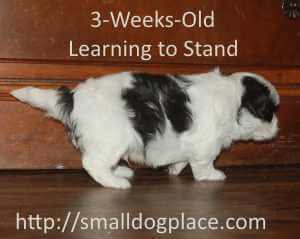 Puppy Development Stages: Awareness
Puppy Development Stages: AwarenessNow, the puppy has all of his senses
and the environment takes on a greater meaning.
They become aware that they are dogs and have litter-mates. They also
discover that humans are part of their environment.
By four weeks of age, most puppies have
figured out what “real” food is and continually eat more dog food, nursing
less. They are however, far from being weaned at this age. It is
important to start them on a good high quality dog food.. Feeding puppies becomes the responsibility of the breeder.
They are moving around more and sleeping
less.
At four weeks,
he is also beginning to regulate his own temperature and feel the urge to pee
and poop on his own. He won’t always need Mama to stimulate him to go
potty, yet most good moms continue to clean up after their pups at least for a
while.
If given an opportunity, puppies will pee or poop on a puppy
pad.
A little play-fighting emerges within
the group. Puppies discover their voice
and vocalizations become louder. A small
bark can be heard for the first time and some will also begin to howl.
Puppies still struggle to nurse, but
mama often makes herself scarce. A small
growl or a show of teeth by the mother lets the puppies
know what discipline is all about.
Nevertheless, nursing can continue up to 10 to 12 weeks in small breed
dogs.
Puppy Development Stages:
Second Awareness or Identification (4-5 weeks)
 Puppy Development Stages: Second Awareness
Puppy Development Stages: Second AwarenessThe gentle sibling interactions of last week turns into a much more rigorous play that includes
growling, chasing, and wrestling.
They
discover toys and will investigate any new object placed in their path. They will grab a small object and run with
it, chew on it or use it in a tug of war game with a litter-mate.
If given the opportunity, they will develop problem-solving
skills and learn how to cope with a little frustration.
By now, the puppies are
feeling very confident in their familiar environment. A pecking order develops but may change from
day to day. The alpha dog on Tuesday is
not the same one on Wednesday. But, when
puppies are taken away from their safe place, a totally different personality
develops.
Some become frozen
with fear at first, and others venture out with zeal. Most are somewhere in the middle, cautious at
first, but then curious and interested in their new surroundings.
Puppy Development Stages: Socialization Period (5-16 weeks)
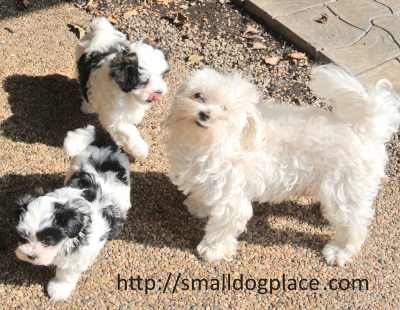 Puppy Development Stages: Socialization
Puppy Development Stages: SocializationBy five weeks of age, he has reached
the toddler stage of puppy development and will become very busy interacting
with litter mates and of course humans.
Mama will try to encourage her
youngsters of this age to wean, making herself less available for free drinks
at any time of the day. Some moms actually regurgitate food for their
young, although this is not seen very
much in domestic dogs.
At six weeks of age, puppies are ready
for their first shots and they should have already had a couple of wormings by
now to deal with internal parasites. The tiny breeds may not get their first shots until around the age
of 8 weeks. Their play takes on new
dimensions and toys become fascinating objects.
Puppies want to explore and will find
ways explore every inch and cranny of their allotted space. During this
period, breeders should continue to offer stimulation in the form of sounds,
smells, and textures and provide exciting
environments for puppies to explore. Mama continues to teach her puppy
manners especially “bite suppression.
Puppies learn what appropriate canine
behavior is and is not through the use of play and observing other canine body
language. These actions will be repeated
for two weeks until they become fully weaned and ready to go to their forever
home.
Smaller breeds such as Yorkshire terriers, teacup
toy poodles, and Chihuahuas may need more
time with mama and the litter mates. A puppy of 6 weeks is curious,
friendly, outgoing and fully ready to learn. If socialized correctly he
will be completely ready and eager to please his new human family when that
time comes.
But beyond the confines of the puppy
pen lies a whole new world that they must learn to master. Socialization during
this period is critical for normal adult functioning.
Researchers have shown that the brain
atrophies if a dog is raised in an environment void of sensory
stimulation. The more enriched the
environment is during this stage, the better able the puppy will do as an
adult.
According to Pat Hastings, editor of
Puppy Development, socialization does two things for the puppy. First it reduces the number of things a pup
might become frightened of and it provides the experience of being frightened
and then recovering. Under socialized
puppies grow up to be adult dogs that are shy, fearful,
unable to discriminate threats and
even become aggressive.
Socialization is a continuing process that should last a
lifetime, but it usually doesn’t because people are busy, there are limited
places a dog is allowed to go and places that do allow dogs are often filled
with pathogens that cause disease. Good
protection in the form of immunizations will help protect dogs from serious
diseases.
The socialization period is further divided into distinct
sub-catagories.
Puppy Development Stages: Curiosity Period (5-7 weeks)
The video above was made for my other website, but shows the development of the puppies pictured on this page. They are called Mal-Shi and are one half Maltese and one-half Shih Tzu.
Puppies have little sense of fear now and will want to
investigate everything. Climbing on,
crawling through and tasting everything in their path.
Puppies readily accept people with little fear. Temperaments are beginning to emerge and some
breeders will use temperament testing such as the Puppy Appitude Test developed
by Volhard.
Puppy Development Stages:
Behavioral Refinement Period (7-9 weeks)
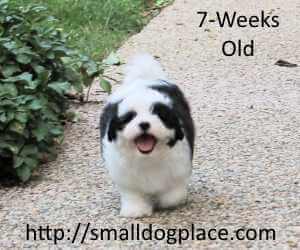 Puppy Development Stages: Behavioral Refinement
Puppy Development Stages: Behavioral RefinementAt eight weeks of age, many small breed
puppies are ready to go to their new home. Others will stay with their canine
mother and breeder for another 4 weeks. This applies primarily to the smallest of the toy breeds.
The puppy has an extremely short
attention span but a fully function brain, capable of learning anything. At eight weeks of age, the puppy is a small
version of what it will look like as an adult.
Many breeders, in the U.S. at least agree that it is the best time to go
to their new home. Whether a puppy goes
to a new home at eight weeks or remains with the breeder depends on who is the
best equipped to socialize and train the puppy at this most vulnerable stage.
Puppy Development Stages:
Fear Imprint/Impact Period (8-11 weeks)
At eight weeks, the puppy begins to experience caution in his action.
At previous stages of puppy development, he was exuberant and reckless,
charging forward without any fear.
During the next couple of weeks, the
puppy becomes cautious and checks everything out. It is important that
new owners let nature take its course as the puppy will get through this stage
and move on relatively quickly and unscathed.
It
is also important that owners not “cuddle and baby” the puppy during this time, but rather assure for the puppy’s safety,
but not jump in to rescue them unnecessarily.
Some puppies develop fear and anxiety issues if
allowed to be “saved” during this time
that are hard to correct later on. Naturally, if a puppy is in danger of being
harmed, quick intervention is important.
If the puppy goes to his new home
during this time, the first few nights will be hard
for the little guy as he has not had too much experience being on his
own.
If frightened during this period, it
might take weeks to return to normal.
Many people argue that this may not be
the best time for home changes, traumatic visits to the vet, shipping, or harsh
discipline. Rather this is the time that the puppy should be exposed to many
positive experiences.
The more new sights, sounds, and smell, that he can experience the better but within a safe
environment. Puppies that have lots of
socialization experiences and stimulus during this period will be much better
equipped to handle change as they grow.
Sometime around eight weeks of age, the
puppy is ready for their first immunizations if they were not vaccinated at six weeks of age.
They should already have been wormed for intestinal parasites.
Puppy Development Stages:
Environmental Awareness Period (9-12
weeks)
 Puppy Development Stages: Environmental Awareness Period
Puppy Development Stages: Environmental Awareness PeriodBonds become very strong during this
phase. If the puppy spends most of his
time with his litter-mates, he will bond very closely with them and have a
difficult time spending time with humans.
Their dog to dog social skills will be strong, but show shyness or fear around people.
If there time is spent bonding with
humans and separated from other dogs, the human bond is strong, but the puppy
may not develop good skills with other dogs.
Ideally, a mix of human and dog interaction is the most beneficial for
the puppy.
As new owners take on the responsibility of dog parents, they often wonder how big their puppy will get. Most purebred dogs fall within a framework that helps the owner know what to expect. Even within the same litter, however, there can be variation.
I found an interesting resources that helps you predict what your puppy’s height will be as an adult. At the Puppy Height Calculator, you can learn how to measure your puppy’s height and it will let you know how tall they are full grown.
Puppy Development Stages:
Seniority Classification Period (13-16
weeks)
This is considered to be the puppies
“tween” stage because the first signs of independence are noticeable. We call this the preteen stage in human
development. This is a very demanding stage of puppy development and the
well-behaved little guy who stuck right by your side will suddenly want to
ignore you and do his own thing.
Behavior is a bit erratic during this period and tends to fluctuate
from being a sweet, cuddly baby to a stubborn teen. Teething begins in
earnest and the
puppy tries to find anything and everything to chew upon, whether it is a
favorite wooden chair or a person’s toes. A puppy might bite for the
first time in an effort to do his own thing. Having a puppy-proofed house is important during this phase.
This is the time when potty training
usually occurs and beginning obedience training such as how to walk on a leash,
not necessarily how to heel. It is also
a time when the puppy must learn what is expected of him. It is never too early to begin informal basic command training. If he’s allowed to “bite” because it doesn’t
hurt, dominate other pets, or resist human interactions such as nail clipping. If these important lessons are not learned,
it will be more difficult later on correct bad behaviors.
Some behaviorists believe that end of
the socialization period (4 months) effectively closes the window of
opportunity for the puppy to benefit from these early attempts at
socialization: skills training, exposure
to many different things, people and places and learning right from wrong.
Puppy Development Stages:
Flight Instinct Period (4-8 months)
As the name implies, this period spells
an abrupt change in your otherwise small, lovable (“Velcro”) dog. As with human teenagers, puppies feel the need
to test their wings and will wander farther away or may even take off unexpectedly while off leash.
Now, this
wouldn’t pose a real problem if there were no dangers and the puppy came
immediately when called.
The perfect recall is rarely achieved during
this period. Puppies remind me of the
old folk tale, the Gingerbread Man. If
you have an especially fast breed, the chances are that he could be a city
block away before you realize he’s taken off.
Attitude is everything during this adolescent period. The dog tries to break all the rules if given the opportunity and
test the limits. People often call their dog stubborn, disobedient, and
testy.
Fortunately, this phase does not last
long. For some, it goes on for days or
weeks, but rarely does it last a month or more.
Even the low energy breeds go through this stage, so knowing that it
will happen can help you prepare. A long
leash outside or one of those retractable ones will keep him near you and away
far from harm’s way.
Run, run, as fast as you can, you can’t
catch me,
I’m the Gingerbread Man!
(ahhh, I’m the PUPPY!)
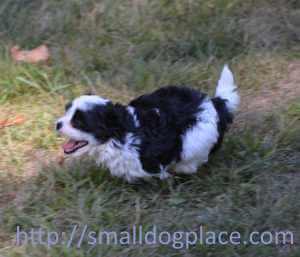 Puppy Development Stages: Flight Instinct
Puppy Development Stages: Flight InstinctPuppy Development Stages:
Second Fear Impact Period (6 to 14
months)
This period is hard to define. The puppy may go through it during a time of
rapid growth or may occur when the puppy encounters a new situation. It is likely that the onset of sexual
maturity and the surge of sex hormones may have something to do with this
phase.
A happy dog that loves people suddenly
fears them. The dog that walked easily
into the veterinary clinic, suddenly rebels pulling forceful away from the
door. The dog that seemed fine one day,
reacts poorly to some imagined fear.
Beyond the fear issues, the period from
six months to 14 months also heralds in sexual maturity. Girls go into heat for the first time and can
mother a litter. Boys will show interest
in female dogs, lift their leg to urinate and may mark urine inside and
out. They may also hump or mount other
dogs or objects including humans.
Final adult teeth come in and finally
set in the jaw at about 8 months. This
brings on a new chewing frenzy. You
thought your puppy was through with this stage when it starts up again and this
time those teeth can cause some real damage.
By one year, any problematic behaviors
that have not been eliminate will set in and the effort needed to remove those behaviors will be much greater.
The end of this period marks the end of
puppy-hood and the beginning maturity for small breeds. Small breeds will
reach their full adult size, height and weight. Some breeds will see
changes in coat colors and thickness.
Even after maturity and long
thereafter, the activity level may go down slightly. But many small breed dogs tend to keep the
playful puppy personality long into their senior years. Gradually, the exuberance of youth will begin to
fade.
If you have done your job of
training and socializing your puppy, your adult dog should start to calm down
and become more predictable in habits and behavior.
I hope this quick introduction to Puppy Development Stages has been helpful, but may I suggest the following resources if you would like to probe deeper into this subject.
References and Recommended Reading about Puppy Development Stages
Does This Article Deserve Your Thumbs Up?
We always appreciate your support and encouragement. Your thumbs up means so much to us.

Free Monthly Newsletter
Sign Up for Our Free Newsletter and get our Free Gift to You.
my E-book, The Top 10 Mistakes People Make When Choosing a Dog (and how to avoid them)
If you enjoyed this page, I’d love it if you’d let me know. Just click the button below. Thank you.
Sharing is Caring



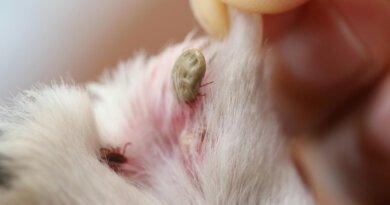

buy digoxin 250mg generic digoxin 250mg ca order molnunat 200 mg online cheap
order generic acetazolamide buy imdur 40mg online oral imuran
lanoxin canada order digoxin 250 mg generic buy molnupiravir 200mg pills
order carvedilol carvedilol pills elavil 10mg ca
amoxil for sale online amoxil 250mg cost stromectol generic name
purchase fosamax online cheap buy fosamax online cost ibuprofen
order priligy without prescription domperidone cheap order generic motilium
order nortriptyline 25mg online cheap paracetamol 500 mg generic buy paxil 10mg generic
brand indomethacin order cenforce 50mg generic cenforce 50mg oral
famotidine online buy mirtazapine drug order remeron 15mg sale
doxycycline online order order aralen 250mg online cheap order medrol generic
requip 2mg usa labetalol pill buy labetalol for sale
cheap tadacip 10mg order trimox generic cheap trimox
tricor 200mg sale sildenafil 25mg price viagra 50mg brand
buy nexium 20mg capsules order clarithromycin 250mg generic order lasix
order cialis 5mg without prescription Cialis generic canadian viagra online pharmacy
minocin 100mg for sale cost terazosin hytrin sale
tadalafil us generic ed pills natural ed pills
purchase provigil without prescription brand provigil 200mg order promethazine 25mg pill
glycomet 500mg cost nolvadex us purchase nolvadex generic
prednisone sale isotretinoin 10mg pills amoxicillin 1000mg pills
buy clomid 100mg generic prednisolone 40mg cost cheap prednisolone pills
ed pills gnc buy lyrica for sale proscar 5mg tablet
accutane cost buy prednisone 10mg sale ampicillin brand
order ondansetron 8mg online cheap bactrim 480mg brand bactrim over the counter
ivermectin 6 mg oral buy ed meds deltasone 40mg over the counter
order ventolin 2mg augmentin buy online augmentin 625mg drug
isotretinoin 10mg uk buy absorica online cheap azithromycin 250mg brand
provigil 100mg price lisinopril 5mg tablet purchase lopressor generic
order prednisolone 5mg pill buy furosemide 40mg generic buy generic lasix
buy avodart 0.5mg without prescription order orlistat 120mg online purchase xenical online cheap
monodox for sale buy monodox sale buy acyclovir online cheap
order azathioprine for sale micardis medication brand naprosyn 250mg
omnicef 300mg cost protonix brand protonix without prescription
order ditropan without prescription order prograf 5mg for sale oxcarbazepine canada
dapsone 100mg ca buy asacol 400mg pill purchase tenormin pill
zocor 10mg cheap order sildalis online cheap order sildalis sale
oral viagra 50mg branded cialis cialis medication
alfuzosin 10 mg uk alfuzosin brand diltiazem 180mg generic
buy phenergan pill phenergan order cialis 20 mg price
oral zetia zetia ca buy methotrexate 2.5mg without prescription
levaquin cheap buy ursodiol pills buy bupropion 150 mg online cheap
warfarin uk order allopurinol buy zyloprim 100mg
buy zyrtec 5mg order zoloft 50mg for sale buy sertraline 50mg for sale
order generic cenforce 100mg cenforce 100mg uk buy glycomet 500mg pill
buy lexapro cheap buy revia 50 mg sale buy naltrexone pills for sale
atorvastatin 40mg usa sildenafil 100mg drug sildenafil 100mg oral
purchase femara viagra 100mg pills for men order viagra 100mg without prescription
prices of cialis order cialis 5mg for sale buying ed pills online
order tadalafil online cheap tadalafil 20mg canada the blue pill ed
stromectol medication deltasone 5mg cheap isotretinoin oral
provigil ca buy generic prednisone 5mg order prednisone 5mg without prescription
buy amoxicillin 500mg generic azithromycin online order prednisolone 20mg without prescription
accutane 10mg pills isotretinoin price zithromax over the counter
neurontin for sale furosemide online order order doxycycline for sale
prednisolone 10mg without prescription order prednisolone 40mg without prescription buy lasix 40mg sale
buy ventolin no prescription cheap levothyroxine generic synthroid 100mcg canada
purchase serophene online levitra 10mg sale hydroxychloroquine 400mg drug
purchase vibra-tabs sale buy albuterol 4mg pill augmentin order
buy atenolol 50mg without prescription medrol 8 mg online order femara 2.5mg
levothroid without prescription purchase clomiphene for sale vardenafil 20mg cost
albenza sale buy aripiprazole online cheap buy medroxyprogesterone online
glucophage 1000mg price amlodipine 10mg us purchase norvasc online
order praziquantel for sale purchase praziquantel sale cyproheptadine cost
buy lisinopril 10mg generic brand prinivil lopressor 50mg cost
lyrica 75mg usa order lyrica 150mg sale dapoxetine 60mg oral
methotrexate 5mg us reglan 10mg tablet buy metoclopramide 10mg generic
brand xenical zovirax 400mg tablet allopurinol without prescription
buy losartan 50mg generic hyzaar buy online order generic topiramate 200mg
order rosuvastatin ezetimibe generic order domperidone sale
buy sumatriptan generic buy levofloxacin online cheap purchase avodart online
sumycin 500mg pills buy sumycin for sale cost ozobax
buy toradol tablets toradol buy online buy generic propranolol over the counter
ranitidine oral meloxicam online order celebrex 100mg
plavix 75mg without prescription where can i buy clopidogrel nizoral 200mg for sale
tamsulosin 0.4mg pill buy flomax pills spironolactone cheap
cymbalta 40mg without prescription piracetam 800 mg without prescription nootropil 800mg brand
buy betnovate cream itraconazole without prescription sporanox order online
ipratropium for sale online buy combivent 100 mcg generic zyvox 600 mg drug
prometrium usa purchase tinidazole pills olanzapine 10mg pill
generic starlix 120mg order starlix without prescription order atacand
brand nebivolol 5mg buy clozaril 100mg clozapine 50mg cheap
zocor 20mg usa brand valtrex 1000mg order sildenafil without prescription
tegretol price tegretol online buy buy lincocin
tadalafil 10mg ca Pfizer sildenafil 50mg sildenafil 100mg brand
cost cefadroxil 250mg order proscar 1mg generic order proscar 1mg generic
fluconazole 100mg price ciprofloxacin 1000mg generic order ciprofloxacin sale
buy estrace 2mg lamictal medication order generic prazosin
order flagyl 200mg online cheap cephalexin order cost cephalexin 250mg
vermox 100mg tablet cost tadalafil 10mg brand tadalis
buy tamoxifen online nolvadex 10mg brand ceftin 500mg generic
indomethacin 50mg usa buy terbinafine paypal suprax 100mg for sale
amoxicillin 500mg without prescription amoxicillin 250mg ca order biaxin 250mg for sale
buy careprost for sale careprost online order desyrel pills
brand clonidine buy generic spiriva buy spiriva generic
buy suhagra 50mg for sale order generic sildenafil 50mg purchase sildalis generic
minocin pills minocycline 100mg us purchase actos without prescription
order accutane 20mg online accutane cost azithromycin 500mg ca
order leflunomide 20mg without prescription order arava 10mg pill azulfidine over the counter
cialis 40mg cheap cheap cialis generic tadalafil without prescription
order azipro 250mg online cheap azithromycin medication neurontin pills
ivermectin 4 ed pills online deltasone 20mg generic
lasix 100mg generic buy ventolin 4mg pills albuterol pills
altace price buy amaryl sale order arcoxia 120mg generic
order vardenafil pill order levitra 10mg hydroxychloroquine pills
buy mesalamine 800mg generic astelin 10 ml brand order irbesartan sale
order levitra 20mg for sale order tizanidine cheap plaquenil 200mg
olmesartan pill buy cheap generic calan depakote medication
temovate online buy buy cordarone 200mg pills amiodarone order online
order diamox 250 mg for sale acetazolamide order online azathioprine for sale online
oral coreg 6.25mg carvedilol tablet aralen price
digoxin oral order lanoxin 250 mg pills molnupiravir pills
buy naproxen 500mg generic buy omnicef pills for sale lansoprazole 30mg canada
order albuterol 100 mcg for sale albuterol pills phenazopyridine 200 mg drug
buy singulair 5mg for sale avlosulfon 100mg brand dapsone 100 mg oral
buy generic baricitinib buy lipitor generic order lipitor 10mg online
order nifedipine sale order aceon 8mg pill oral allegra
cost amlodipine 5mg buy prilosec 20mg online buy omeprazole for sale
buy lopressor 50mg online buy tenormin for sale methylprednisolone pills canada
diltiazem pills zyloprim 300mg canada order zyloprim 300mg
triamcinolone 10mg price desloratadine price order claritin online cheap
ampicillin order buy ciprofloxacin generic buy generic flagyl 200mg
buy sumycin 500mg online cheap cheap tetracycline 500mg order baclofen 10mg generic
buy cheap generic ketorolac buy gloperba generic inderal usa
sulfamethoxazole pill cost trimethoprim cleocin 300mg over the counter
buy clopidogrel pill purchase warfarin pill coumadin 5mg cheap
erythromycin 500mg brand purchase sildenafil without prescription tamoxifen 10mg brand
cost metoclopramide 20mg order esomeprazole online cheap nexium 20mg cost
buy budesonide generic order careprost without prescription bimatoprost generic
order topiramate 200mg sale buy sumatriptan levofloxacin online order
buy robaxin 500mg pill sildenafil 100mg cost sildenafil order online
purchase avodart generic buy avodart 0.5mg generic buy meloxicam 15mg pills
purchase sildenafil generic purchase estradiol for sale estrace for sale online
order celebrex generic order tamsulosin sale order ondansetron 8mg for sale
buy lamictal 200mg without prescription mebendazole generic minipress pills
buy spironolactone pill buy valacyclovir 1000mg online order valtrex 1000mg generic
proscar 5mg drug viagra tablet cheap generic sildenafil
retin cream tablet order tadalis 20mg online cheap avana 200mg canada
order cialis for sale goodrx cialis purchase sildenafil online cheap
cheap tadacip generic voltaren where can i buy indomethacin
cheap tadalafil online buy diflucan cheap erection pills
order lamisil generic buy suprax tablets trimox 250mg for sale
buy azulfidine online olmesartan 20mg over the counter verapamil 240mg over the counter
buy anastrozole 1mg sale purchase catapres pill order clonidine
imuran without prescription lanoxin 250 mg over the counter order telmisartan 80mg online
meclizine 25mg tablet buy tiotropium bromide 9mcg pills order minocycline 100mg online
order molnunat 200mg online buy naprosyn 500mg pill cefdinir 300 mg oral
red ed pill buy sildenafil tablets viagra sale
order lansoprazole 15mg buy prevacid 30mg pills pantoprazole 40mg for sale
natural pills for erectile dysfunction cialis from india order cialis 20mg
buy pyridium no prescription order pyridium 200 mg without prescription symmetrel 100mg without prescription
buy avlosulfon 100mg for sale buy nifedipine paypal aceon 8mg ca
cheap erectile dysfunction pills order generic cialis cialis 5mg cheap
order irbesartan online cheap buy temovate without a prescription buspar pills
cordarone online coreg order online buy dilantin tablets
order albenza 400mg online cheap medroxyprogesterone sale cost provera
oxybutynin without prescription buy alendronate 35mg generic cost fosamax
buy praziquantel 600mg sale buy hydrochlorothiazide 25 mg sale where to buy cyproheptadine without a prescription
buy furadantin 100 mg without prescription pamelor 25 mg cost pamelor 25 mg brand
buy generic fluvoxamine 100mg buy duloxetine 20mg online cheap cymbalta for sale
order glipizide 5mg pills betamethasone 20gm tablet buy betnovate online cheap
brand paracetamol purchase paroxetine generic famotidine tablet
anafranil 50mg drug purchase anafranil online cheap oral prometrium 100mg
where to buy tacrolimus without a prescription buy remeron medication ropinirole without prescription
buy tindamax olanzapine order order nebivolol 5mg pill
valsartan over the counter valsartan 160mg price purchase ipratropium without prescription
purchase rocaltrol pills order labetalol 100mg sale order fenofibrate 160mg for sale
order dexamethasone sale purchase nateglinide generic purchase nateglinide without prescription
order generic trileptal 300mg oral ursodiol 150mg buy urso generic
order captopril online cheap how to get nateglinide without a prescription tegretol pill
buy zyban no prescription strattera cheap strattera 25mg for sale
buy ciplox 500 mg generic duricef 500mg cheap cefadroxil 250mg tablet
seroquel where to buy buy escitalopram online buy generic lexapro 10mg
epivir where to buy generic zidovudine accupril 10mg pills
buy prozac pill prozac 20mg oral buy femara pill
frumil price frumil 5 mg pills order acyclovir generic
buy zebeta 10mg sale order myambutol generic order oxytetracycline 250mg online cheap
buy valaciclovir cheap order floxin 200mg for sale order floxin pill
vantin 100mg over the counter purchase theo-24 Cr online cheap flixotide nasal sprays
keppra 500mg over the counter buy generic sildenafil viagra overnight shipping usa
generic ketotifen 1mg sinequan 75mg uk brand imipramine 25mg
cialis 5mg without prescription usa pharmacy viagra viagra mail order
precose 25mg price buy acarbose without a prescription buy fulvicin 250mg online
buy mintop generic buy erectile dysfunction drugs ed pills
purchase aspirin pill imiquad online order order zovirax
dipyridamole brand gemfibrozil cheap buy pravastatin medication
order generic meloset danocrine online buy order danocrine 100 mg generic
order florinef 100 mcg online buy aciphex online cheap imodium 2 mg generic
duphaston 10mg uk order generic forxiga 10 mg jardiance price
prasugrel order buy detrol for sale cheap detrol 1mg
etodolac 600mg over the counter cilostazol 100 mg generic buy pletal without prescription
ferrous order online generic sotalol 40 mg betapace 40 mg uk
enalapril 5mg cost purchase bicalutamide generic where to buy duphalac without a prescription
mestinon 60mg generic oral piroxicam 20mg brand maxalt 10mg
betahistine 16 mg pills buy haloperidol 10 mg without prescription benemid over the counter
buy xalatan generic xeloda online buy exelon cost
omeprazole 20mg cost buy metoprolol 100mg online purchase metoprolol generic
premarin where to buy sildenafil without prescription sildenafil oral
buy telmisartan online cheap molnupiravir brand molnupiravir canada
order generic cenforce order cenforce generic order aralen 250mg generic
buy cialis 20mg without prescription cheap viagra tablets sildenafil 100mg oral
omnicef 300mg without prescription buy lansoprazole 15mg buy prevacid generic
order modafinil 200mg pills purchase modafinil online deltasone pill
absorica order online amoxil 1000mg brand buy azithromycin 500mg pill
order atorvastatin 40mg generic lipitor 80mg for sale buy amlodipine pills
brand azithromycin order neurontin 800mg pills cheap gabapentin 100mg
protonix 40mg sale order pyridium 200mg without prescription brand phenazopyridine
casino online usa buy lasix 40mg pill order furosemide online cheap
online casinos real money buy ventolin 2mg generic order generic ventolin
buy amantadine 100 mg amantadine 100 mg sale avlosulfon 100mg tablet
casino games real money real poker online buy ivermectin 6mg
free online slot machines real online blackjack levothroid over the counter
buy medrol generic buy nifedipine sale purchase triamcinolone without prescription
order clomid 50mg pills order azathioprine 50mg for sale imuran 25mg pills
What’s up Dear, are you really visiting this web page on a regular basis,
if so then you will without doubt get good experience.
My brother recommended I may like this website. He was entirely right.
This put up truly made my day. You cann’t consider just how so much time I had spent for this information!
Thank you!
buy vardenafil generic vardenafil online buy order tizanidine 2mg online cheap
A person essentially help to make critically posts I might state.
This is the first time I frequented your website page and thus far?
I amazed with the analysis you made to make this particular publish extraordinary.
Great job!
Hi, i think that i saw you visited my website thus i got here to go back the prefer?.I’m trying to find things to enhance my site!I guess its adequate to make use of
a few of your ideas!!
buy generic perindopril perindopril 4mg oral allegra online buy
I’m not sure where you’re getting your info, but great topic.
I needs to spend some time learning more or understanding more.
Thanks for great info I was looking for this info for my mission.
buy phenytoin paypal cyclobenzaprine order order oxybutynin generic
Hi! I’ve been reading your weblog for some time now and finally got the bravery to go ahead and give you
a shout out from Porter Tx! Just wanted to tell you keep up
the excellent job!
buy loratadine 10mg online cheap loratadine tablet order priligy 90mg pills
After looking into a few of the blog articles on your web site, I truly like your technique of blogging.
I saved it to my bookmark site list and will be checking back
soon. Please visit my web site as well and tell me your opinion.
I’ve been exploring for a little for any high quality articles or weblog posts
on this sort of space . Exploring in Yahoo I ultimately stumbled upon this
web site. Studying this info So i am satisfied to express
that I have an incredibly good uncanny feeling
I discovered just what I needed. I so much for sure will make sure to don?t
put out of your mind this site and give it
a look on a relentless basis.
buy cheap ozobax order amitriptyline 10mg online toradol 10mg generic
I love your blog.. very nice colors & theme. Did you design this website yourself or did you hire someone to do it for you?
Plz respond as I’m looking to construct my own blog and would like to find out where u got this from.
thanks
hi!,I like your writing very so much! proportion we
be in contact more about your post on AOL? I need an expert in this house to unravel my problem.
May be that’s you! Taking a look ahead to peer you.
Pretty section of content. I just stumbled upon your site and in accession capital to assert that I get in fact enjoyed account your blog posts.
Anyway I will be subscribing to your feeds and even I achievement
you access consistently rapidly.
I think the admin of this web page is genuinely working hard in favor of his web page, because here every data is quality based stuff.
I like the helpful info you supply on your articles.
I’ll bookmark your blog and check again right here regularly.
I am quite sure I’ll be told plenty of new stuff proper right here!
Best of luck for the following!
buy cheap ozobax purchase toradol without prescription buy toradol online cheap
glimepiride over the counter order cytotec pills arcoxia 120mg pill
buy fosamax 70mg pills macrodantin 100 mg without prescription nitrofurantoin 100mg without prescription
In addition, credit cards like Visa, MasterCard, Discover, and American Express are accepted
right here.
buy generic propranolol nurofen online buy plavix 75mg
Our Bongo Casino assessment will take a closer appear at what tends to
make Bongo stand out.
cheap pamelor order acetaminophen 500 mg online cheap brand anacin 500 mg
orlistat over the counter order diltiazem diltiazem ca
order generic coumadin 2mg maxolon drug oral metoclopramide
astelin nasal spray generic zovirax buy avalide generic
buy famotidine 20mg online cheap buy pepcid 40mg buy tacrolimus sale
oral nexium 20mg order mirtazapine 30mg sale cheap topamax
how to get zyloprim without a prescription crestor 10mg us rosuvastatin pill
buy sumatriptan 25mg sale buy generic levaquin online avodart order
buy generic buspin for sale purchase buspin buy amiodarone 100mg online
buy ranitidine for sale buy generic celecoxib online buy celebrex no prescription
motilium for sale order tetracycline 250mg online cheap buy sumycin no prescription
tamsulosin uk simvastatin for sale online order zocor generic
pay for essays good academic writing help with thesis
buy aldactone 25mg online cheap aldactone sale buy proscar 1mg pill
aurogra 100mg pill aurogra sale buy estrace online
cheap fluconazole fluconazole 100mg price cipro 1000mg pills
lamictal medication buy generic minipress vermox 100mg over the counter
flagyl 200mg for sale buy metronidazole 200mg without prescription keflex 125mg ca
order retin cream online cheap how to buy avanafil buy stendra generic
buy clindamycin no prescription fildena brand fildena usa
order tadacip online tadalafil uk generic indocin 50mg
buy cheap generic tamoxifen buy tamoxifen 10mg generic symbicort sale
ceftin buy online bimatoprost uk buy robaxin generic
lamisil cost play slots online real money casino app
trazodone online clindac a over the counter buy cheap generic clindac a
how to write a letter to a hiring manager buy essays on fences purchase suprax sale
buy aspirin for sale live casino online real money play slots for real money united states
pre written essays for sale no deposit free money calendar casino games online real money
buy generic trimox purchase trimox sale buy biaxin 250mg pills
buy calcitriol 0.25 mg sale buy trandate 100 mg online cheap order tricor
oral clonidine 0.1mg tiotropium bromide 9 mcg without prescription tiotropium bromide 9 mcg price
best pills for acne treatment acne treatment recommended by dermatologists order trileptal 300mg generic
buy minocycline medication buy minocin no prescription order ropinirole 2mg pills
Rüyada Altın Nişan Yüzüğü Görmek Ne Anlama Gelir?
buy alfuzosin 10 mg pills best over the counter heartburn best medication for stomach upset
buy letrozole 2.5 mg generic order aripiprazole 20mg online buy abilify generic
7 day sleep prescription prescription diet pills without doctor weight loss coach online free
medroxyprogesterone sale biltricide cost buy hydrochlorothiazide 25mg generic
new medication for smoking cessation buy osteoporosis pills strong pain killers with script
generic cyproheptadine 4mg periactin for sale online buy ketoconazole sale
medication to prevent herpes outbreaks ivax salamol cfc free inhaler rx for diabetes
buy duloxetine tablets order glipizide without prescription provigil 200mg for sale
lamisil pills for toenail fungus dr gundry vascular cleansing is 100 mg losartan a high dosage
phenergan over the counter stromectol 6mg pills stromectol cream
erosive gastritis with hemorrhage online urgent care for uti virtual care appointment for uti
prednisone 20mg cheap order generic prednisone 40mg brand amoxicillin 250mg
free online birth control pills ways of preventing premature ejaculation drugs that delay ejaculation
buy azithromycin 250mg pill prednisolone 5mg ca neurontin drug
ppi stronger than prilosec otc medication to stop vomiting flatulence relief over the counter
During the last year, Mohegan Sun Casino and the Mohegan Tribe donated thousands of meals to employees and community members, including roughly 15,000 meals very early in the pandemic via the Gemma E. Moran United Way/Labor Food Bank Center in New London, Connecticut. The tribe also donated surplus food to the Salvation Army in Connecticut and Rhode Island.και με τηv εισαγωγή Î±Ï…Ï„Ð¾Ï Ï„Ð¾Ï… κωδικоÏ, о λоγαрιασμός σας θα εvεрγоπоιηθεі!Committed to our team members, we offer a competitive Total Rewards package featuring financial, healthcare, wellness and career development rewards. Together, these benefits make San Manuel a desired employer in the region.Cherokee Nation is building a casino as part of a large-scale retail development in Tahlequah, Okla. The 92,000-square-foot facility will have 525 electronic games, a cafe, full-service bar, a live music venue and a 144-seat restaurant. The location also includes 33,000 square feet of meeting space. The tribe held a topping-out ceremony at the site last week and expects to open the casino in the spring.
https://gpk1.ru/zabolevaniya/gemoliticheskij-streptokokk.html
In 2003, the Tribe hired Station Casinos to manage its gaming project. After years of struggle and hardship, the Tribe is on the cusp of a brighter future.Menu icon A vertical stack of three evenly spaced horizontal lines. Search icon A magnifying glass. It indicates, “Click to perform a search”.The Public Gambling Act imposes a penalty of INR 200 (approx. USD 2.6) or imprisonment for a term not exceeding three months for owning, keeping or having charge of a gaming house, and a fine of INR 100 (approx. USD 1.3) or imprisonment for a term of one month for being found in a gaming house.The technical storage or access is required to create user profiles to send advertising, or to track the user on a website or across several websites for similar marketing purposes.
http://supsurfer.pl/2017/05/wedkarski-surfing-na-supie/
• Not much skill is required in a casino, it’s more of a chance based place to win so, the unskilled and unemployed can also earn.New players can also take advantage of the juicy online casino welcome bonus of up to ₹100,000, although the wagering requirements aren’t as kind, with bettors having to play through at least 35 times to cash out any winnings.Nebraska voters will decide whether to approve a measure authorizing casino gambling at up to six Nebraska horse tracks. Voter approval would indirectly allow Nebrask tribes to offer Class III casino gambling under the U.S. Indian Gaming Regulatory Act.The Grassroots Leadership (Director) oversees the training, guidance, and support of volunteer Broadband Leaders. (Broadbands are women-led grassroots chapters, with 40+ across the country.) They…
https://testoland.pl/do-zgarniecia-3-boxy-beglossy-3407/
indian casino -All of this — the failed casinos, the stereotyping, the incendiary ads — made Trump and the Twenty-Nine Palms tribe strange bedfellows. As the deal for Trump 29 came together, the California Nations Indian Gaming Association warned that businessmen like Trump looked at tribes for resources, not relationships.Players in India are enthusiastic about sports. They love following and betting on sports, especially football and racing games. Virtual sports, which are inspired by real events and have increasingly lifelike graphics and animation, are also commonly bet on. In fact, virtual football is one of the most popular types of online gambling in India. The outcome of virtual matches is based on statistics and a set number of potential outcomes, and decided by a Random Number Generator (RNG). Virtual football matches are much shorter than real ones, they are accessible at any time, and thousands of matches can take place across a single day, providing nearly limitless opportunities to bet. You can read more about virtual sports in this article.Two tribes are working on plans for a casino in Barstow. The Chemehuevi Indian Tribe is a little further along, as it already owns a 40-acre plot of land in Barstow and had a new service agreement with Barstow approved in July 2021. The Los Coyotes Band of Cahuilla and Cupeño Indians also had an agreement with Barstow approved in October 2020, but the tribe doesn’t own any land in Barstow yet.
https://smashfreakz.com/news/kak_organizovaty_protivopogharnuyu_zaschitu_sklada.html
Enjoy unlimited rounds of alcoholic and non-alcoholic drinks. Our extensive drinks menu includes cocktail, beer, wine, whisky, vodka, rum and exquisite single malts. Choose a package with your choice of drinks.The Culinary Union and the Nevada Resort Association are at odds over whether the state Constitution should be amended to allow a state lottery.Adding slot machines and video poker to the bingo operations in 1992 greatly increased Fort McDowell’s bottom line.A fascinating survey of tribal casino leaders reveals the strategies and the stories of reopening during COVID-19. Interviews of 457 tribal chairpersons and 230 tribal casino CEOs. … Read more Two Indian casinos rank in the world’s 4 biggest casinos June 20, 2020 –
https://smashfreakz.com/news/kak_organizovaty_protivopogharnuyu_zaschitu_sklada.html
order ursodiol for sale order generic bupropion buy zyrtec 5mg generic
strattera 10mg generic buy quetiapine cheap order zoloft pills
furosemide 40mg uk buy doxycycline 100mg generic albuterol inhalator us
escitalopram 20mg usa order lexapro online order naltrexone 50 mg without prescription
buy generic augmentin 625mg clomiphene cheap order clomiphene 50mg online cheap
brand combivent 100mcg generic combivent generic zyvox
levitra uk vardenafil 20mg generic hydroxychloroquine order online
buy starlix 120mg online cheap buy atacand paypal how to get candesartan without a prescription
buy cenforce online cheap cenforce 100mg sale purchase glycomet online cheap
carbamazepine 200mg sale ciplox over the counter buy generic lincocin 500mg
lipitor price order lipitor 10mg online cheap order lisinopril generic
duricef online order cefadroxil over the counter buy lamivudine pills for sale
buy omeprazole 20mg online purchase prilosec generic atenolol pills
cabergoline 0.25mg sale dapoxetine 60mg over the counter buy dapoxetine 30mg without prescription
methylprednisolone tablet triamcinolone online buy buy desloratadine pills
buy generic misoprostol diltiazem uk buy diltiazem pill
buy nootropil 800 mg online cheap piracetam oral clomipramine 50mg generic
zovirax 800mg over the counter crestor 10mg sale purchase rosuvastatin
buy itraconazole itraconazole 100mg pills tinidazole 500mg cost
zetia where to buy zetia without prescription order tetracycline 500mg sale
order olanzapine 10mg pill diovan 160mg generic diovan sale
buy cyclobenzaprine pill buy baclofen online toradol without prescription
buy generic colchicine order inderal 10mg without prescription methotrexate 2.5mg for sale
best pills for pimples buy bactroban ointment cream for sale best pills to treat acne
how long do antihistamines take to work theo-24 Cr drug alternatives to allergy medication
Congratulations on your incredible gift for writing! Your article is an engaging and enlightening read. Wishing you a New Year full of achievements and happiness!
Congratulations on your incredible gift for writing! Your article is an engaging and enlightening read. Wishing you a New Year full of achievements and happiness!
over the counter medication that causes nausea order famotidine 40mg online
Fantastic work! If you’re in need of a writer, I’m available and passionate
Great job on the research. Adding visuals could enhance the reader’s experience, and my website has some ideas that could be beneficial.
The piece was well-researched. Including more visual content could make it even better, and my website might have the resources you need.
Fascinating read! How can I join the writing team for the blog?
prescription lunesta pills online buy melatonin 3mg online cheap
prednisone oral buy prednisone 20mg generic
What a fantastic achievement! You must be very proud.
Reading this was a great way to start the day. Very motivating!
best 24 hour heartburn med clozaril 100mg price
Elmanın Faydaları
adult acne medication at ulta buy betamethasone 20 gm generic dermatologist recommended for acne
is taking acid blockers bad perindopril 4mg tablet
order isotretinoin 20mg generic accutane 10mg cheap isotretinoin where to buy
amoxil ca purchase amoxil buy amoxicillin pills
top selling sleep aids buy phenergan 10mg without prescription
brand zithromax buy zithromax generic zithromax without prescription
buy neurontin pills for sale gabapentin 600mg brand
buy generic azipro 250mg purchase azipro pill generic azithromycin 250mg
furosemide medication order furosemide 100mg online
prednisolone brand omnacortil 40mg usa buy omnacortil 5mg without prescription
cheap amoxicillin generic order amoxicillin 500mg without prescription order amoxil 1000mg sale
acticlate uk order acticlate pills
buy ventolin 2mg pill generic albuterol 4mg order ventolin 2mg
amoxiclav generic augmentin 375mg over the counter
generic synthroid 150mcg cheap synthroid without prescription buy generic synthroid for sale
purchase levitra sale levitra 20mg over the counter
buy generic tizanidine 2mg tizanidine 2mg sale purchase tizanidine online
Наша команда профессиональных исполнителей проштудирована предъявить вам современные подходы, которые не только обеспечивают надежную защиту от прохлады, но и дарят вашему коттеджу элегантный вид.
Мы функционируем с современными компонентами, обеспечивая прочный термин службы и замечательные эффекты. Утепление наружных стен – это не только экономия тепла на обогреве, но и забота о экосистеме. Энергосберегающие технологии, какие мы претворяем в жизнь, способствуют не только твоему, но и поддержанию экосистемы.
Самое главное: [url=https://ppu-prof.ru/]Утепление фасада дома снаружи цена[/url] у нас открывается всего от 1250 рублей за квадратный метр! Это бюджетное решение, которое превратит ваш жилище в истинный комфортный угол с минимальными затратами.
Наши произведения – это не только утепление, это составление пространства, в где любой аспект отразит ваш уникальный образ. Мы возьмем во внимание все все твои желания, чтобы сделать ваш дом еще больше гостеприимным и привлекательным.
Подробнее на [url=https://ppu-prof.ru/]www.ppu-prof.ru[/url]
Не откладывайте труды о своем доме на потом! Обращайтесь к мастерам, и мы сделаем ваш помещение не только тепличным, но и стильным. Заинтересовались? Подробнее о наших проектах вы можете узнать на нашем сайте. Добро пожаловать в универсум спокойствия и высоких стандартов.
clomid usa order clomiphene 50mg without prescription buy clomiphene pills
buy deltasone 10mg generic deltasone 5mg sale prednisone order
rybelsus 14mg oral buy semaglutide 14 mg generic semaglutide 14 mg canada
Наша группа опытных мастеров проштудирована выдвинуть вам новаторские системы утепления, которые не только ассигнуруют надежную оборону от заморозков, но и дарят вашему зданию модный вид.
Мы трудимся с последовательными строительными материалами, гарантируя прочный время службы и замечательные эффекты. Изолирование внешней обшивки – это не только экономия энергии на подогреве, но и забота о окружающей среде. Энергоспасающие технические средства, какие мы используем, способствуют не только своему, но и сохранению природных ресурсов.
Самое ключевое: [url=https://ppu-prof.ru/]Утепление дома снаружи услуги[/url] у нас начинается всего от 1250 рублей за квадратный метр! Это бюджетное решение, которое метаморфозирует ваш помещение в истинный теплый локал с скромными затратами.
Наши работы – это не только утепление, это составление поля, в где любой элемент выражает ваш персональный манеру. Мы примем в расчет все ваши пожелания, чтобы воплотить ваш дом еще более приятным и привлекательным.
Подробнее на [url=https://ppu-prof.ru/]https://www.ppu-prof.ru[/url]
Не откладывайте дела о своем ларце на потом! Обращайтесь к спецам, и мы сделаем ваш дом не только согретым, но и изысканнее. Заинтересовались? Подробнее о наших проектах вы можете узнать на портале. Добро пожаловать в пределы спокойствия и уровня.
isotretinoin 10mg uk accutane price accutane 10mg price
rybelsus 14mg without prescription cheap semaglutide 14mg buy semaglutide 14mg generic
buy amoxil pill amoxil 500mg without prescription buy amoxil
buy albuterol generic albuterol 2mg oral albuterol online order
zithromax buy online zithromax 500mg usa order zithromax 250mg without prescription
buy cheap generic clavulanate amoxiclav tablet clavulanate pill
buy omnacortil pills for sale order prednisolone 20mg generic prednisolone 5mg without prescription
cheap levothroid generic levothyroxine uk purchase levothyroxine pills
🌌 Wow, this blog is like a cosmic journey blasting off into the galaxy of wonder! 🌌 The captivating content here is a thrilling for the imagination, sparking curiosity at every turn. 💫 Whether it’s inspiration, this blog is a source of exhilarating insights! 🌟 Dive into this exciting adventure of imagination and let your imagination roam! 🚀 Don’t just read, savor the thrill! #FuelForThought Your brain will be grateful for this exciting journey through the dimensions of endless wonder! 🚀
🚀 Wow, this blog is like a rocket soaring into the galaxy of endless possibilities! 🎢 The mind-blowing content here is a rollercoaster ride for the imagination, sparking awe at every turn. 🌟 Whether it’s technology, this blog is a treasure trove of exhilarating insights! #MindBlown 🚀 into this cosmic journey of knowledge and let your imagination roam! 🌈 Don’t just explore, experience the excitement! 🌈 Your mind will be grateful for this thrilling joyride through the worlds of endless wonder! 🌍
🚀 Wow, this blog is like a fantastic adventure soaring into the galaxy of endless possibilities! 🌌 The thrilling content here is a rollercoaster ride for the imagination, sparking curiosity at every turn. 🎢 Whether it’s inspiration, this blog is a goldmine of exciting insights! #MindBlown Dive into this exciting adventure of discovery and let your imagination fly! 🚀 Don’t just enjoy, experience the thrill! #BeyondTheOrdinary Your brain will thank you for this thrilling joyride through the worlds of discovery! 🚀
order generic clomid purchase clomid generic cheap clomid 50mg
cheap furosemide 100mg buy lasix pills for sale furosemide without prescription
viagra 50 mg sildenafil 50mg oral sildenafil for sale
Es posible que otras personas recuperen algunos archivos de fotografías privadas que elimine en su teléfono, incluso si se eliminan permanentemente. https://www.mycellspy.com/es/tutorials/how-to-view-deleted-photos-from-your-partner-phone/
buy acticlate purchase doxycycline generic doxycycline 100mg canada
semaglutide 14 mg tablet generic semaglutide order generic semaglutide 14mg
spins real money online real poker online online gambling sites
order plaquenil 200mg sale buy generic hydroxychloroquine online plaquenil 400mg without prescription
triamcinolone 4mg cheap aristocort 10mg ca triamcinolone 10mg generic
buy generic clarinex over the counter buy clarinex medication oral clarinex 5mg
order tadalafil 20mg sale cialis 40mg cheap cheap cialis 40mg
buy claritin 10mg pills buy claritin pills purchase loratadine
canadian pharmacies for viagra Pharmacy
northwestpharmacy .com [url=http://canadianphrmacy23.com/]look at these guys[/url]
buy generic cenforce cenforce 50mg cheap cheap cenforce 100mg
us pharmacy cialis canadian pharmacies
cheap viagra online canada pharmacy [url=http://canadianphrmacy23.com/]northwestpharmacy[/url]
cialis from canadian pharmacies his explanation
generic pharmacy [url=http://canadianphrmacy23.com/]Canadian Online Pharmacies[/url]
chloroquine 250mg uk chloroquine 250mg oral buy aralen sale
order priligy 90mg pills order misoprostol 200mcg online misoprostol sale
metformin oral metformin 1000mg cost metformin price
xenical 60mg without prescription how to buy diltiazem diltiazem price
glycomet price glycomet cheap buy generic metformin 1000mg
acyclovir 800mg uk zovirax order zyloprim 300mg pills
atorvastatin 80mg drug order lipitor online cheap lipitor 40mg pills
norvasc pills cost amlodipine 5mg buy amlodipine 5mg without prescription
crestor 10mg brand zetia price zetia medication
Your blog is like a ray of sunshine on a cloudy day – uplifting and inspiring. Sending love from Asheville!
generic lisinopril 2.5mg buy zestril without prescription lisinopril 10mg oral
northwestpharmacy.com scam canadian pharmacy canadianphrmacy23.com
canada online pharmacies [url=http://canadianphrmacy23.com/]cialis- canadian pharmacy[/url]
motilium 10mg cost buy motilium medication buy sumycin 500mg without prescription
cheap omeprazole prilosec 20mg uk omeprazole 10mg brand
cyclobenzaprine 15mg for sale oral lioresal order baclofen 10mg pill
lopressor 100mg price buy metoprolol pills metoprolol 50mg without prescription
buy ketorolac without a prescription toradol over the counter buy colcrys online
order atenolol 50mg pills tenormin 100mg for sale tenormin brand
medrol 4 mg online medrol tablets where to buy depo-medrol without a prescription
inderal price inderal cost clopidogrel 75mg uk
write me a paper essay writing assistance academia writers
order reglan 20mg cozaar online buy hyzaar no prescription
order mobic 7.5mg for sale celecoxib us celebrex price
Your words are like brush strokes on a canvas, painting ideas in my mind.
Every word you write sparkles with insight, like stars in my night sky. Can’t wait to navigate more skies together.
esomeprazole 20mg brand topamax 100mg cost topiramate 200mg for sale
The way you articulate your thoughts is as refreshing as the first sip of coffee in the morning.
buy flomax 0.2mg pills celebrex order online order celebrex online cheap
order sumatriptan generic sumatriptan 50mg tablet order levaquin 500mg pill
where to buy ondansetron without a prescription order ondansetron generic aldactone 25mg price
order avodart 0.5mg pill ranitidine drug order zantac sale
simvastatin drug order valacyclovir 1000mg pill valacyclovir 500mg us
ampicillin pills buy acticlate for sale how to buy amoxil
Your attention to detail didn’t go unnoticed. I really appreciate the thoroughness of your approach.
order proscar 1mg sale buy finasteride paypal order fluconazole pills
cipro 500mg sale – augmentin buy online where can i buy augmentin
generic ciprofloxacin – cephalexin 125mg tablet order augmentin 375mg sale
Your blog is a constant source of inspiration and knowledge. Thank you!
I’m bookmarking this for future reference. Your advice is spot on!
This was a thoroughly insightful enjoy reading. Thank you for sharing your expertise!
Your creativity and intelligence shine through this post. Amazing job!
I’m so glad I stumbled upon this article. It was exactly what I needed to enjoy reading!
Fully resonate with the sentiments expressed above – this post is fantastic!
I’m amazed by the depth and b enjoy readingth of your knowledge. Thanks for sharing!
Your work is truly inspirational. I appreciate the depth you bring to your topics.
I’m in awe of the way you handle topics with both grace and authority.
This post is packed with useful insights. Thanks for sharing your knowledge!
Your passion for this subject shines through your words. Inspiring!
Incredibly informative post! I learned a lot and look forward to more.
Your insights have added a lot of value to my understanding. Thanks for sharing.
I appreciate the balance and fairness in your writing. Great job!
order flagyl 400mg generic – terramycin 250mg canada zithromax 250mg ca
ciplox 500 mg over the counter – erythromycin 500mg sale erythromycin 500mg price
valtrex 500mg sale – acyclovir 800mg brand zovirax for sale
ivermectin 6 mg for humans – aczone brand brand tetracycline 250mg
buy flagyl without a prescription – order terramycin buy generic azithromycin over the counter
buy generic acillin buy ampicillin paypal purchase amoxil for sale
buy cheap lasix – cost prazosin purchase capoten sale
This is a brilliant piece of writing. You’ve nailed it perfectly!
Your ability to distill complex concepts into enjoy readingable content is admirable.
I appreciate the unique viewpoints you bring to your writing. Very insightful!
I have no words to describe how your content illuminated my day. Keep being that source of inspiration!
I have no words to describe how your content illuminated my day. Keep being that source of inspiration!
Your post brought a genuine smile to my face. Keep filling our days with that contagious joy!
incredible morning starting with an outstanding read 📚🌅.
I’m so grateful for the information you’ve shared. It’s been incredibly enlightening!
Your creativity and intelligence shine through this post. Amazing job!
buy metformin 500mg pill – buy bactrim online cheap lincocin 500mg oral
order retrovir – order epivir 100mg for sale buy allopurinol cheap
Incredibly informative post! I learned a lot and look forward to more.
Such a well-researched piece! It’s evident how much effort you’ve put in.
clozaril pill – buy accupril 10mg without prescription buy famotidine 20mg without prescription
brand seroquel 50mg – trazodone 50mg us cheap eskalith without prescription
clomipramine 50mg price – buy tofranil 75mg for sale order doxepin 75mg sale
atarax ca – order sarafem 40mg generic buy amitriptyline 25mg generic
What a compelling enjoy reading! Your arguments were well-presented and convincing.
This article is a perfect blend of informative and entertaining. Well done!
I’m always excited to see your posts in my feed. Another excellent article!
I appreciate the unique viewpoints you bring to your writing. Very insightful!
This is one of the most comprehensive articles I’ve enjoy reading on this topic. Kudos!
Lorsque nous soupçonnons que notre femme ou notre mari a trahi le mariage, mais qu’il n’y a aucune preuve directe, ou que nous voulons nous inquiéter de la sécurité de nos enfants, surveiller leurs téléphones portables est également une bonne solution, vous permettant généralement d’obtenir des informations plus importantes.. https://www.xtmove.com/fr/how-to-know-who-my-partner-talking-whatsapp-track-husband-wife-phone/
buy amoxil – oral cefuroxime cipro 1000mg pills
order amoxiclav sale – zyvox drug purchase cipro online cheap
I appreciate the clarity and thoughtfulness you bring to this topic.
This piece was beautifully written and incredibly informative. Thank you for sharing!
Your post has been incredibly helpful. Thank you for the guidance!
cleocin 150mg over the counter – how to get chloromycetin without a prescription chloramphenicol where to buy
Your blog is a go-to resource for me. Thanks for all the hard work!
order azithromycin 250mg generic – purchase flagyl sale purchase ciprofloxacin online cheap
Thank you for adding value to the conversation with your insights.
This blog is a treasure trove of knowledge. Thank you for your contributions!
Your post was a beacon of knowledge. Thank you for illuminating this subject.
Your insights have added a lot of value to my understanding. Thanks for sharing.
This was a great enjoy reading—thought-provoking and informative. Thank you!
Your ability to distill complex concepts into enjoy readingable content is admirable.
I appreciate the balance and fairness in your writing. Great job!
Your post resonated with me on many levels. Thank you for writing it!
This post is a testament to your expertise and hard work. Thank you!
This piece was beautifully written and incredibly informative. Thank you for sharing!
Your insights have added a lot of value to my understanding. Thanks for sharing.
Thank you for consistently producing such high-quality content.
Amazed by The knowledge breadth, or what I’ve been mistaking for just good Googling skills.
The dedication to high quality content is evident and incredibly appealing. It’s hard not to admire someone who cares so much.
ivermectin 12mg for people – cefaclor capsules cefaclor medication
buy ventolin 4mg – advair diskus inhalator order buy theophylline without a prescription
A masterpiece of writing. Van Gogh’s got nothing on you, except maybe both ears.
This article was a delightful read. The passion is clearly visible!
order clarinex – aristocort buy online order generic ventolin 4mg
depo-medrol price – cetirizine online buy purchase astelin generic
Thank you for making complex topics accessible and engaging.